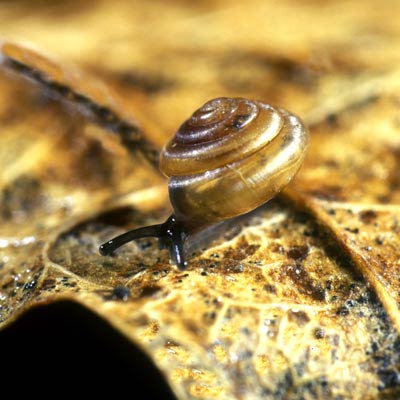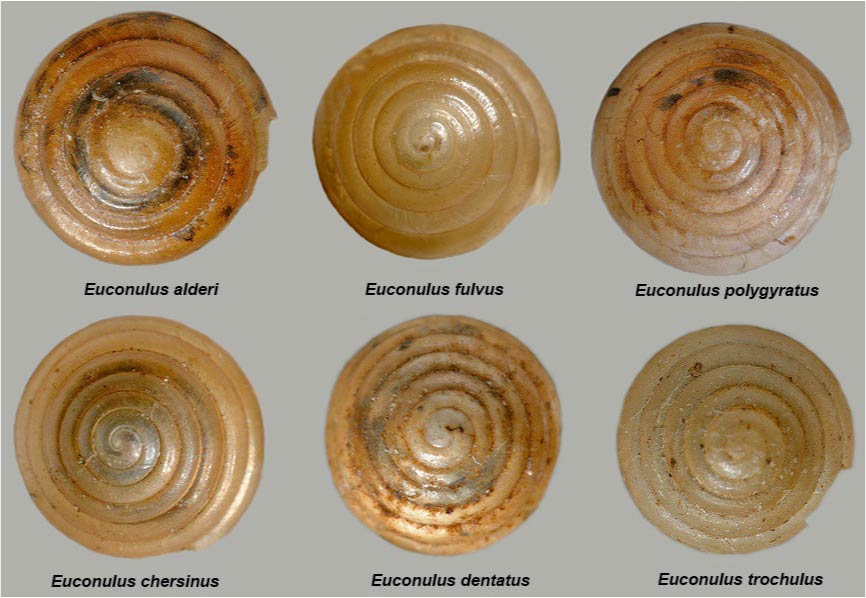Euconulidae
|
Euconulus fulvus. (Photo: © Dr. Roy Anderson, MolluscIreland) |
|
Euconulus spp. (Photo: © B. Frank, Jacksonville) |
|
Euconulus spp. (Photo: © B. Frank, Jacksonville) |
Family
Euconulidae
Species
Euconulus spp.
Common name
Brown hive, Hives
E. alderi: Shiny hive
E. chersinus: Wild hive
E. dentatus: Toothed hive
E. fulvus: Brown hive
E. polygyratus: Fat hive
E. trochulus: Silk hive
Description
This small group of snails only attains a maximum widthWidth:
The width of the shell is the maximum distance across the shell (including the aperture).
of 3.5 mm. They are generally dome or bee hive-shaped, pale brown and glossy. The apertureAperture:
The major opening of a shell that the body of the animal may be retracted.
is crescent shaped. There are approximately 25 species in the genus Euconulus, with six species currently occurring in the eastern U.S.:
E. alderi: 2.1 mm high, 2.3-2.8 mm wide, 5.2 whorlsWhorls:
Pleural of whorl. A whorl is a complete spiral turn/growth of the shell of a mollusc. The whorls are counted from the apex outwards.
E. chersinus: 2.35 mm high, 2.5 mm wide, 6.6 whorls
E. dentatus: 2.75 mm high, 2.5 mm wide, 6.9 whorls
E. fulvus: 3.2 mm high, 3.4 mm wide, 6.5 whorls
E. polygyratus: 2.4 mm high, 2.75 mm wide, 6.8 whorls
E. trochulus: 2.4 mm high, 2.45 mm wide, 5.9 whorlsWhorls:
Pleural of whorl. A whorl is a complete spiral turn/growth of the shell of a mollusc. The whorls are counted from the apex outwards.
Native range
Holarctic
Distribution
North America:
- U.S.: Central and Eastern
- Canada
Europe
Australasia: New Zealand
Ecology
This snail genus inhabits cool, calcareousCalcareous:
Consisting of limestone or calcium carbonate.
wetlands, lowland conifer, coastal dune/beaches or grassy meadows. E. alderi is a protected species in Michigan.
References
Grimm et al. 2009Grimm et al. 2009:
Grimm, F.W., R.G. Frosyth, F.W. Scheler and A. Karstad. 2009. Indentifying land snails and slugs in Canada. Introduced species and native genera. Canada Food Inspection Agency. Ottawa, ON. pp. 1-168.; Forsyth 2004Forsyth 2004:
Forsyth, R.G. 2004. Royal BC museum handbook: land snails of British Columbia. Victoria, Canada: Royal BC Museum. pp. 1-188.; Kerney et al. 1979Kerney et al. 1979:
Kerney, M.P., R.A.D. Cameron and G. Riley. 1979. A field guide to the land snails of Britain and North-west Europe. Collins, London. pp. 288.; Michigan Natural Features Inventory 2007Michigan Natural Features Inventory 2007:
Michigan Natural Features Inventory. 2007. Rare Species Explorer (Web Application). [Accessed August 17, 2010].; Perez and Cordeiro 2008




